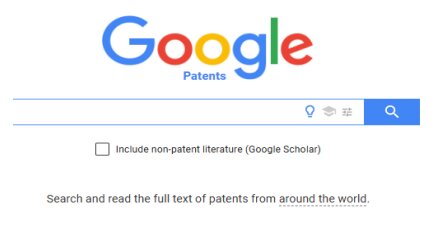Patent registration
Conducting a patent search, while not mandatory, is a crucial step in the patent registration process. For an inventor, performing a thorough search to determine the eligibility of their invention is highly advisable before proceeding with the patent application. This step significantly reduces the risk of having the invention rejected by ensuring it meets all necessary criteria. A comprehensive patent search helps identify prior art, similar inventions, or existing patents that could pose obstacles, thereby allowing inventors to refine their applications accordingly. By investing time in this initial search, inventors can save valuable resources and increase the likelihood of a successful patent grant.
SOURCES FOR PATENT SEARCH

There are 5 most popular search engines for patent search
- INDIAN PATENT ADVANCE SEARCH SYSTEM:The India Patent Information Retrieval System (IPAIRS) is an advanced tool for searching specific patents on the IP India website. Introduced in 2015, IPAIRS provides comprehensive text and detailed information about all Indian patent applications through a single, user-friendly interface. It significantly enhances the ability to explore patent-related information in India, making it the most reliable and widely used resource for patent searches. It Hosted on the IP India website, IPAIRS allows users to search for specific patents, offering comprehensive text and detailed information about all patent applications filed across India. This system provides a single-window interface, making it easy for researchers, legal professionals, and inventors to access crucial patent data.
- ESPACENET: It is a free online service for searching patents and patent applications. Developed by the European Patent Office in collaboration with the member states of the European Patent Organization, it provides access to over 100 million patent documents from more than 100 countries. This service is particularly helpful to patent holders by offering advanced search features such as classification search, cited search, and similarity search, enabling them to patent their inventions without risk of infringement. The website is continuously updated, providing details about new and innovative inventions and patent applications.
- PATENT AGENT: “A person who files patent application” A patent agent play a crucial role in patent search Patent agents play a crucial role in assisting inventors and organizations in securing patents by thoroughly understanding the invention, conducting comprehensive prior art searches to ensure novelty and non-obviousness, and preparing detailed patent applications. They write legally enforceable claims to define the scope of the invention’s protection, revise applications based on feedback from patent examiners, and strategically decide when to abandon applications if necessary. By navigating the complexities of patent law, they help inventors protect their intellectual property and bring their innovations to market.
- GOOGLE PATENT:google patents is a free tool provided by google that allows to search patents and patent application from various countries to patent user. A patent user may search any patent by entering a keyword, patent numbers, investor names, etc. in search bar It is a very easiest way for any patent user to find out the patent application just by enter a name of patent name of patent holder. It gives all over information regarding the patent application.
- PATENT SCOPE:Patent scope is a critical source of patent search, defining the boundaries of a patent's protection, and is determined by the claims, specifications,drawings, and prosecution history. Analyzing patent scope helps identify relevant prior art, determine patentability, conduct infringement analysis, and identify licensing opportunities. Understanding patent scope is essential for evaluating patent validity, identifying potential infringement, conducting thorough prior art searches, evaluating patent strength, and supporting patent landscaping and mapping. By carefully reading claims, studying specifications and drawings, reviewing prosecution history, searching for prior art, and considering patent scope in search results, searchers can leverage patent scope to conduct accurate and comprehensive searches, leading to better decision-making and strategic outcomes.

TIPS FOR EFFECTIVE PATENT SEARCHING
BENEFITS OF PATENT SEARCH
- REDUCING THE RISK OF INFRINGNMENT:By conducting thorough research on existing patent applications before registering their invention, users can significantly reduce the risk of infringing on existing patents. This research also helps prevent future litigations by identifying similar inventions and patent applications, thereby saving time and money. Through diligent research, users can ensure that their invention is novel and non-obvious, and avoid potential legal disputes and costly lawsuits."
- MONITOR COMPETITIVE ACTIVITY:A patent holder can continuously keep a watchful eye on their business competitors through regular patent searches. This enables them to stay informed about new inventions and innovations introduced in the market, which can inspire improvements to their existing invention to meet evolving public demand. By staying abreast of competitors' developments, they can refine their existing patent, identify opportunities for innovation, and maintain a competitive edge in the market."
- REDUCES COST:By conducting thorough and prior research on existing patents and patent applications, a patent user can significantly reduce the costs associated with the registration process. Knowledge of prior compliances and understanding of patent registration requirements provide direct guidance, enabling the patent user to avoid unnecessary expenses that may arise from lack of knowledge about patents. This informed approach streamlines the registration process, mitigates potential pitfalls, and optimizes resource allocation.
- IDENTIFYING OPPORTUNITIES:Patent search is very helpful through which user can grab the opportunities on pinpointing areas where existing patents and products fall short, enabling innovation and development of new solutions. Discovering areas where technological advancements can be made, leading to novel inventions and improved products.
- ENHANCE THE KNOWLEDGE OF NEW GENERATION:Enhancing the knowledge of the new generation is a significant benefit of patent search, allowing young inventors, researchers, and students to gain insight into state-of-the-art technologies, learn from previous achievements and mistakes, understand technological evolution, develop critical thinking and problem-solving skills, foster creativity and innovation, build upon existing knowledge, and develop a deeper understanding of intellectual property, enabling them to stand on the shoulders of giants, avoid duplication of effort, and focus on cutting-edge research and development, driving progress and innovation.
FAQs
Q1.How is a patent search conducted?
Ans.Patent searches involve searching patent databases, such as the USPTO or EPO, using keywords, classifications, and other search strategies.
Q2.What is the difference between a patent search and a trademark search?
Ans.A patent search focuses on inventions and innovations, while a trademark search focuses on brand names, logos, and slogans.
Q3.Can we search patent applications of all over the world?
Ans.Yes, through Google Patents, users can search patent applications from all over the world.
Q4.What is the use of patent search?
Ans.Patent search is useful for patent holders, allowing users to check the availability of a patent application before registering a new device.

